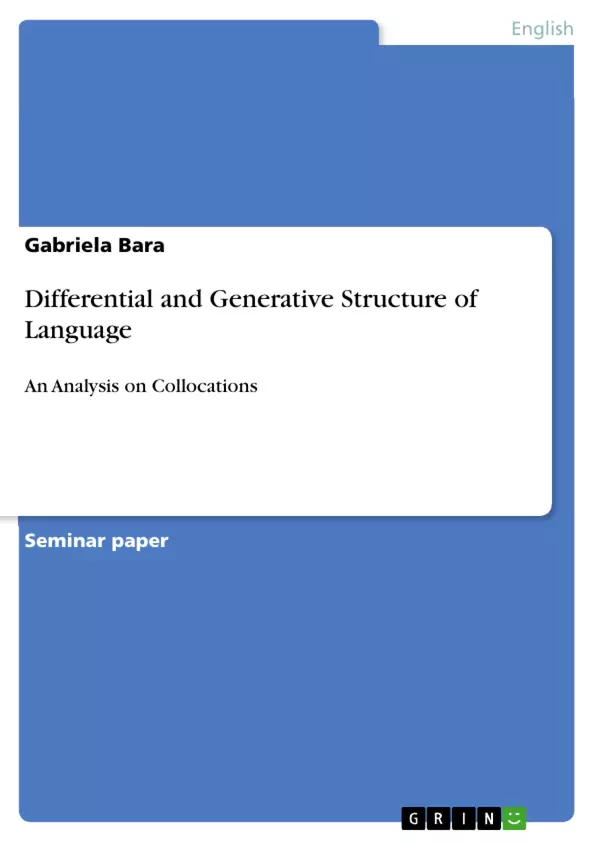The theory and methodology of early linguistics took the notion of structure as a key term and emphasized the idea that language needed to be organized. In the 70s, under the influence of pragmatics, language was no longer seen as an abstraction, but as a means of communication between people, and the primary purpose of language became the exchange of meaning. Since language essentially deals with naming of concepts, the importance of lexis replaced the role played by grammatical structure. The idea was that meaning is primarily carried by lexis, because focus on communication implies emphasis on lexis and decreased emphasis on structure.
In this paper, I will discuss the central ideas of Saussurean structuralism, in particular the notion of differential structure, then I will present the innovation brought in linguistics by Chomsky’s generative structure, namely the universal nature of language as opposed to Sassure’s idea about the uniqueness of language, and finally, I will analyze collocations in the light of these two structuralist theories.
This paper does not intend to show the differences and incompatibilities between the structural and lexical approaches, but the point of coincidence and agreement between the two, namely the way meaning is defined through difference under the exercise of choice.
Inhaltsverzeichnis (Table of Contents)
- I. Introduction
- II. The Saussurean linguistic model
- II.1. Structure and structuralism
- II.2. The linguistic sign
- II.3. Two – dimensional structure of language: syntagmatic and paradigmatic axes
- II.4. Differential structure of language
- III. Generative structure in Chomsky's syntagmatic approach
- III.1. Syntagmatic and paradigmatic approach in structural linguistics
- III.2. Generative syntax
- IV. Collocations
- IV.1. Lexical collocations
- IV.2. Grammatical collocations
- V. Syntagmatic constraints and paradigmatic contrasts in collocations
- VI. Conclusions
Zielsetzung und Themenschwerpunkte (Objectives and Key Themes)
This paper aims to explore the central ideas of Saussurean structuralism, particularly the concept of differential structure. It will then introduce Chomsky's generative structure and its contribution to linguistics, focusing on the universal nature of language in contrast to Saussure's notion of uniqueness. Finally, the paper analyzes collocations through the lens of these two structuralist theories.
- Saussurean structuralism and the concept of differential structure
- Chomsky's generative structure and the universal nature of language
- The analysis of collocations within the framework of structuralist theories
- The role of choice and difference in defining meaning
- The interplay of syntagmatic and paradigmatic axes in language structure
Zusammenfassung der Kapitel (Chapter Summaries)
- I. Introduction: This chapter introduces the historical context of linguistics, highlighting the shift from a focus on structure to a focus on meaning and communication. The author outlines the paper's objectives and the key concepts to be explored, emphasizing the importance of lexis and the role of choice in defining meaning.
- II. The Saussurean linguistic model: This chapter delves into the core concepts of Saussurean structuralism, presenting the notion of structure as central to understanding language as a functional system. The chapter examines the idea of meaning requiring structure, explores the structure of language through syntagmatic and paradigmatic axes, and highlights the concept of differential structure, where meaning is determined by the relationship between words.
- III. Generative structure in Chomsky's syntagmatic approach: This chapter introduces Chomsky's generative structure, focusing on its emphasis on the universal nature of language as opposed to Saussure's emphasis on uniqueness. The chapter explores the interplay of syntagmatic and paradigmatic approaches in structural linguistics and discusses the concept of generative syntax.
- IV. Collocations: This chapter introduces the concept of collocations, distinguishing between lexical and grammatical collocations. It lays the groundwork for further analysis of collocations in relation to structuralist theories.
- V. Syntagmatic constraints and paradigmatic contrasts in collocations: This chapter explores the interplay of syntagmatic constraints and paradigmatic contrasts in collocations, analyzing how these principles contribute to the meaning and structure of collocations.
Schlüsselwörter (Keywords)
This paper focuses on the key concepts of structural linguistics, particularly differential and generative structure. It examines the linguistic sign, syntagmatic and paradigmatic axes, and the concept of collocations. The paper aims to highlight the role of choice and difference in defining meaning within the framework of structuralist theories.
- Quote paper
- Gabriela Bara (Author), 2005, Differential and Generative Structure of Language, Munich, GRIN Verlag, https://www.grin.com/document/144329



